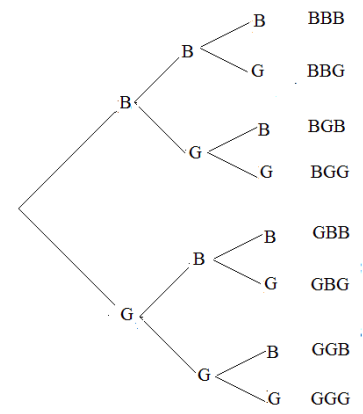
1. In a city election, there are 2 candidates for mayor, and 3 for supervisor. Use a tree diagram to find the number of ways to fill the two offices.
Click here to check your answer
The offices can be filled in 6 different ways.
If you missed this problem, review Section 5.2. (Note that this will open in a new window.)
2. For lunch, a small restaurant offers 2 types of soups, three kinds of sandwiches, and two types of soft drinks. Use a tree diagram to determine the number of possible meals consisting of a soup, sandwich, and a soft drink.
Click here to check your answer
There are 12 different possible meals.
If you missed this problem, review Section 5.2. (Note that this will open in a new window.)
If two coins are tossed, what is the probability that both coins will fall heads? The problem seems simple enough, but it is not uncommon to hear the incorrect answer 1/3. A student may incorrectly reason that if two coins are tossed there are three possibilities, one head, two heads, or no heads. Therefore, the probability of two heads is one out of three. The answer is wrong because if we toss two coins there are four possibilities and not three. For clarity, assume that one coin is a penny and the other a nickel. Then we have the following four possibilities.
The possibility HT, for example, indicates a head on the penny and a tail on the nickel, while TH represents a tail on the penny and a head on the nickel. It is for this reason, we emphasize the need for understanding sample spaces.
An act of flipping coins, rolling dice, drawing cards, or surveying people are referred to as a probability experiment. A sample space of an experiment is the set of all possible outcomes.
A single die is rolled. Write the sample space.
A die has six faces each having an equally likely chance of appearing. Therefore, the set of all possible outcomes \(S\) is
A family has three children. Write the sample space showing the birth order with respect to gender. (This means that one possibility is having a boy, then a boy, then a girl. A different possibility is having a girl, then a boy, then a boy.)
The sample space consists of eight possibilities.
The possibility BGB, for example, indicates that the first born is a boy, the second born a girl, and the third a boy.
We illustrate these possibilities with a tree diagram.

Two dice are rolled. Write the sample space.
Let's suppose one of the dice is red, and the other green. We have the following 36 possibilities.